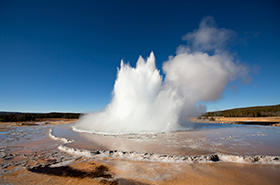 Discover six potential sources of renewable energy and the capacity factor of each. The capacity factor is a percentage that speaks to the efficiency of a particular energy. It is helpful in illustrating how actual production compares to potential production.
Discover six potential sources of renewable energy and the capacity factor of each. The capacity factor is a percentage that speaks to the efficiency of a particular energy. It is helpful in illustrating how actual production compares to potential production.
All information comes from the Energy Information Administration (EIA) within the U.S. Department of Energy, unless otherwise noted.

Solar
Solar PV
The most recognizable form of solar technology is photo-voltaic, known as Solar PV, which converts sunlight directly into electricity.
Capacity Factor: 24.6% (based on California)
Source: EIA
Solar Thermal
This form of solar energy captures heat energy from sunlight, usually trapping this heat in a medium such as water. Such processes can provide hot water for residential uses, and in some cases can reduce the energy needed to power the steam cycle in existing generation plants.
Essentially, most solar thermal technologies do not add power to the existing grid, but help reduce the use of electricity. This is an important distinction when considering the applicability of solar thermal in meeting renewable energy standards that require new sources of energy generation.
A related technology called Concentrated Solar Power (CSP) does hold potential for electricity generation, although, very few areas of the United States receive the amount and quality of required sunlight.
Capacity Factor: 56% for “power towers” and 73% for parabolic troughs
Source: National Renewable Energy Laboratory

Wind
Wind energy uses turbines to convert wind energy into electricity.
People have used this technology for centuries to power small applications, but now wind energy is being used for large-scale electricity generation.
According to the EIA, producing electricity from wind requires sustained winds of 14 miles per hour. In the United States, the few inland areas that meet such a threshold include the region from north Texas through the Great Plains.
Offshore wind is also a possibility, although a number of obstacles exist, including hurricane hazards, animal habitats and migratory flight paths, natural reefs, and varying ocean floor conditions.
Currently, all of the world’s offshore wind farms are within 15 miles of the coast.
Capacity Factor: 44%
(Class 6 = the strongest wind classification)
Source: EIA

Hydroelectric
Currently, hydroelectric is one of the most plentiful renewable sources in the U.S., especially in the Pacific Northwest, parts of the Southeast, and New York State.
Hydroelectric facilities use the energy of moving water to turn giant turbines and produce electricity. Hydroelectric is often a “load-following” source of energy, meaning generation can be ramped up during peak load periods.
In addition, the regulation of water levels in rivers and lakes means hydroelectric facilities cannot run all the time.
Therefore, while hydroelectric facilities are highly efficient when they are in operation, their significant downtime yields a relatively small capacity factor.
Capacity Factor: 36.3%
Source: EIA

Biomass
A range of organic material holds the potential for energy production, including energy crops such as switchgrass, residues from crops, wood waste, logging residues, and other matter from forests. In some cases, these biomass sources are burned at high temperatures to produce electricity.
Among the most prominent examples are pulp and paper mills that use forest byproducts to generate power for the mill, a process known as co-generation.
In some cases, biomass can be co-fired with other energy sources such as coal, although the content of biomass allowable for mixture is generally limited to 20% or lower.
In recent years, states have permitted a number of biomass plants designed specifically for electricity generation. One such project at Plant Mitchell near Albany, Georgia, will produce as much as 96 megawatts of power using wood mass from a 100-mile radius around the plant.
Capacity Factor: 80% (co-firing)
Source: EIA

Geothermal
Using heat generated under the Earth’s surface, geothermal technology is a major source of renewable energy in certain parts of the world such as Iceland, the Philippines, and parts of California.
When available, geothermal energy is capable of producing relatively large quantities of electricity with virtually no emissions.
According to the EIA, geothermal technology usually requires underground temperatures of at least 150° Celsius. The vast majority of such underground temperatures in the United States are located west of the Mississippi River.
Capacity Factor: 87%
Source: EIA
Landfill Gas
One of the least known forms of renewable energy is landfill gas. In some cases, large landfill operations produce enough methane and carbon dioxide to produce small amounts of electricity.
Although landfill gas operations can be very efficient, they are capable of producing only small amounts of electricity.
While this makes such operations ideal for smaller projects, e.g. municipal power projects, landfill gas operations are among the least likely options to add renewable energy to the current power grid.
Even large landfill gas operations are normally in the range of 5 megawatts, and about half of the nation’s eligible landfills already produce energy from landfill gas.
Capacity Factor: 88%
Various Sources





